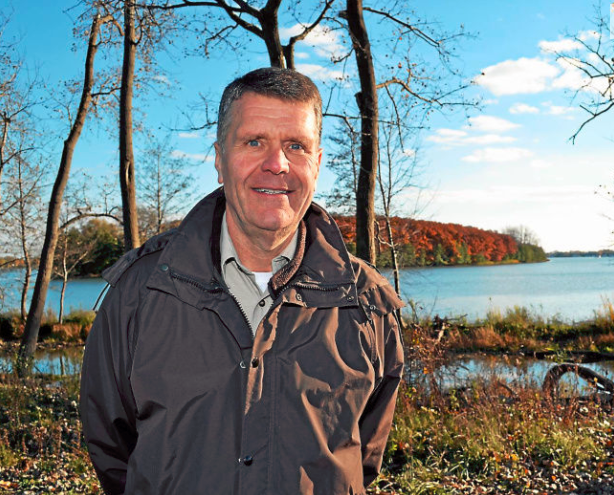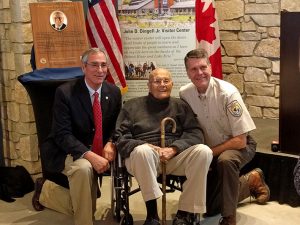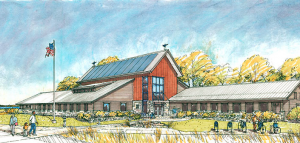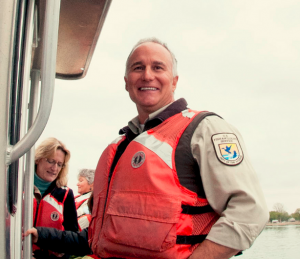
He created North America’s only International Wildlife Refuge
Another leader who has made an indelible mark on the Great Lakes is stepping down.
At John Hartig’s recent retirement party, friends and colleagues he’d worked with for more than 30 years at U.S. Fish and Wildlife fought back tears as he hugged, shook hands,
held his grandchildren, and showed his co-workers he could actually wear something other than his tan government uniform.
Many seemed shocked when they saw him in a tux and said they’d never seen him this dressed up before.
A Crowning Achievement: The International Wildlife Refuge
John Hartig has been Refuge Manager for the Detroit River International Refuge for 14 years.
His career began at the University of Michigan where he worked in Great Lakes Research. He took a job working on the State of Michigan’s Great Lakes Nearshore Surveillance Program and eventually joined the International Joint Commission where he worked for 12 years. He became the River Navigator for the Greater Detroit American Heritage River Initiative for 5 years.
And that’s what lead him to his crowning achievement: the creation of the only International Wildlife Refuge in North America 20 miles south of Detroit.

Regional Director Tom Melius with former Congressman John Dingell Jr. and Refuge Manager John Hartig, courtesy of fws.gov
The refuge was established in 2001 as a result of bi-national efforts between the United States and Canada to build a sustainable future for the Detroit River and western Lake Erie ecosystems.
Hartig tells Great Lakes Now: “I’ve always – from the time I was a young child – loved the out of doors. We would canoe on Belle Isle, fish along the Detroit River, and vacation in cottages up north each summer. Then growing up in the late 60’s when the Rouge River caught on fire, and there was all the pollution – I couldn’t understand the contrast between the pristine waters of the north and what was going on down here.”
Hartig says he became involved in environmental issues from a very young age. “I was a product of Earth Day. I was a high school student in the 70’s. I wanted to make a difference. My parents taught us about the true meaning of stewardship. “
“Where’s the next generation of conservationists and sustainability entrepreneurs going to come from?”

Artist rendering of the Detroit River International Wildlife Refuge Gateway Visitor Center, courtesy of fws.gov
Though he has accomplished many things in his life (he’s won dozens of awards, authored or co-authored more than 100 publications on the environment, and written four books), he is best known for making history by overseeing the development of The International Wildlife Refuge.
He says, “We took 25 people from Canada and 25 people from the United States and we said, ‘What do you want for this region?’ That group of people came up with a conservation vision, calling for something that no one else in America had. Congressman John Dingell picked it up. Canada’s prime minister and Peter Stroh got involved. Canada followed up. And it became law. And today we stand with North America’s only International Wildlife Refuge. But the most important thing was that vision.”
Hartig says, “80 percent of the people in the United States and Canada now live in urban areas. Where’s the next generation of conservationists and sustainability entrepreneurs going to come from? They are going to come from urban areas.”
Hartig says he believes the International Wildlife Refuge will help create leaders to protect the Great Lakes for decades to come. He says, “So: what I have been so fortunate to be part of is bringing conservation to cities and making nature a part of everyday urban life to inspire the next generation of conservationists.”
Leaving a Path Forward
Though Hartig is now retiring from his work at the Refuge, he is NOT retiring from his work.
Hartig tells Great Lakes Now: “I am going to become a Fulbright scholar at the Balsillie School of International Affairs in Waterloo, Ontario. I will be working between Canada and the United States and looking at what we’ve achieved and learned through 32 years of clean-up of the most polluted areas – areas of concern – and the impact of the Great Lakes Restoration Initiative to finish the job and leave a legacy for generations.”

Jim Boase, US Fish and Wildlife Service, courtesy flickr.com
Jim Boase has worked with Hartig at the the U.S. Fish and Wildlife Service for many years. He tells Great Lakes Now Hartig “is probably one of the most infectious people in terms of his appeal for the outdoors and his love for the city of Detroit and for what’s happening along the Detroit River. He is awesome. He’s certainly going to be missed! He was the perfect person to take an urban refuge and do what he’s done.” Boase adds, “It’s no surprise to me that he was chosen for a Fulbright.”
Second Chief D’Arcy Tammaro with the Wyandot of Anderdon Nation says, “He’s a great guy and he’s helped our nation out a lot. It’s great to meet somebody who’s so committed like John. An area between Detroit and Toledo is protected now because of his hard work. The wildlife and the fish are coming back because of him.” Tammaro says he wants Hartig to know how appreciate he is of the work he’s done. He says, “You’ve taught us all so much. You’ve left us a path forward.”
Note from Great Lakes Bureau Chief Mary Ellen Geist: We are pleased to announce that John Hartig has agreed to become a regular contributor to Detroit Public Television’s Great Lakes Bureau greatlakesnow.org as he continues to do research on the Great Lakes and complete his Fulbright. We are looking forward to having John’s expertise become part of our ongoing coverage of the Great Lakes.




